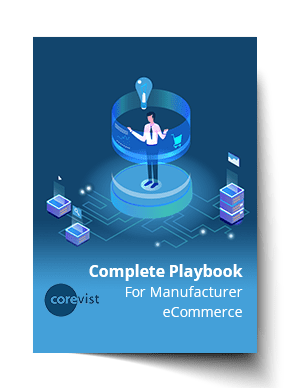Share
Author
George Anderson
Share
In the world of manufacturer eCommerce, strategies are as varied as the organizations pursuing them. How do you know what strategies your company should pursue?
In this post, we’ll give you five simple questions to ask as you hash out your manufacturing eCommerce strategy. With the answers to these questions in hand, you’ll be equipped to make decisions that move your organization forward.
Let’s get started!
1. Are you going to sell to your existing channel partners through B2B eCommerce?
If you sell primarily to dealers or distributors, then they’re a great target for your manufacturing eCommerce strategy.
By moving existing business online, you can launch eCommerce to a captive audience, which reduces the financial risk of the project. Not only will you demonstrate a quick win to internal stakeholders, but you’ll create a better customer experience for your existing channel partners.
If you plan to launch B2B eCommerce for this segment, be sure to read question four below. We discuss the depth of SAP ERP integration required to create a great eCommerce experience for dealers and distributors.
NEW Guide:
Your Complete Playbook for Manufacturer eCommerce
Here are 4 keys to successful eCommerce channel for manufacturers.
2. Are you going to sell directly to the end user of your products?
Some manufacturers already do this. Where the end user is a business customer (for example, a doctor’s office buying directly from a medical manufacturer), then this is still considered B2B eCommerce.
For manufacturers that sell consumer products, selling direct means removing the middleman. In this case, you’re looking at a D2C (direct-to-consumer) model.
Whether selling direct means B2B or D2C for your organization, this strategy may require a different approach from selling to dealers and distributors. Since the audience isn’t so captive, you may need a more B2C-style user experience to attract and retain customers.
For more information, check out this post: Manufacturers Selling Direct To Consumers.
3. Is your goal to improve customer experience or to expand your footprint?
Whether you’re selling to existing channel partners or directly to end users (or both), it’s worth asking a larger question about your goals. Are you primarily looking to become “easier to do business with” for your existing customers? Or are you trying to attract new customers?
While most manufacturers end up doing both, it’s best to clarify your strategy by choosing one of these goals for your initial project. Doing so will help you focus your efforts (and your choices).
4. Do your customers need real-time SAP ERP data?
Manufacturers that rely on SAP ERP for all business processes need to think carefully about integrating eCommerce and SAP. No matter which customer segment(s) you’re targeting with eCommerce, chances are, they’ll need some form of SAP integration if eCommerce is going to work for them.
So how much SAP integration do you need?
Take a look at your customer segment(s) and ask yourself if they need any of these features in eCommerce.
- Real-time inventory availability from SAP
- Dynamic pricing based on contract rules in SAP
- Personalized catalogs or picklists based on SAP logic
- Real-time credit status in eCommerce (so they know if an order will go on credit block)
- Instant order posting to SAP (so they know their order has claimed available inventory)
- Real-time order status and history from SAP (so they don’t call customer service for routine questions)
- The ability to view and pay invoices online, with real-time clearing in SAP
If your users need even one of these features in eCommerce, you’ll want to think strategically about your SAP integration. For many manufacturers, that integration can make or break the eCommerce initiative.
5. How much SAP integration complexity can you take on?
Here’s where manufacturing eCommerce strategies diverge.
If you’re selling directly to consumers, you may not need that much SAP integration.
If you’re selling to dealers, distributors or other channel partners, you’re going to need a comprehensive SAP integration. Without it, your customers can’t get the personalized data and logic they need to complete transactions.
But how can you provide that comprehensive integration?
At a most basic level, you have two options for your integration architecture.
- Standalone eCommerce platform with third-party integration software. In this architecture, you’ll need three systems (eCommerce, integration platform and SAP ERP), each with its own duplicate copy of all relevant data and logic. You’ll have to maintain all three systems — typically with three separate teams. Since data is basically copied and pasted between systems (through batch updates), there’s a greater chance of data sync problems.
- Managed eCommerce platform that includes SAP integration. In this architecture, your eCommerce provider manages the solution for you (including SAP integration). You maintain data and logic in one place only — SAP. Data is never copied. Rather, it’s written and read in real time, eliminating all possibility of data sync issues.
Option number two is the architecture on which Corevist Commerce is built. Our platform includes prebuilt, configurable integration to SAP ERP that covers just about every use case we see with manufacturers. Since we take care of the eCommerce solution and the integration, organizations can sell online with Corevist Commerce without having to take on the burden of SAP integration management.
NEW Guide:
Your Complete Playbook for Manufacturer eCommerce
Here are 4 keys to successful eCommerce channel for manufacturers.










